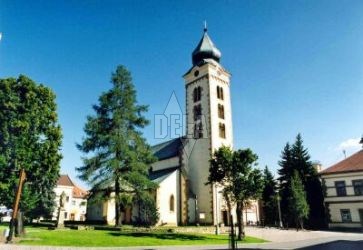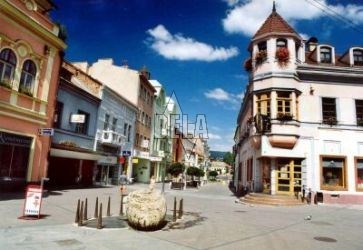


|
Tourist destinations | Towns and villages | Maps | Map | Hikes to the surroundings Accommodation and Services |

 Thanks to its excellent natural conditions, historical cultural monuments and preserved folk architecture it is one of the most beautiful and by tourist most visited regions in Slovakia. It is situated in the south-eastern part of the administrative area of the city of Žilina (northern part of Slovakia), surrounded by the most important Slovak mountains -
Vysoké Tatry (High Tatras) in the east,
Západné Tatry (West Tatras) and
Chočské vrchy (Chočské Hills) in the north,
Nízke Tatry (Low Tatras) in the south and
Veľká Fatra (Great Fatra) in the west. All these unique mountains with breathtaking valleys offer very suitable facilities for hiking, mountain biking, but first of all for winter sports. Ski centers offer outstanding conditions for down-hill as well as cross-country skiing. The ski centers in
Demänovská dolina (Demänovská Valley),
Malinné,
Jasná,
Chopok, Bocká dolina (Bocká Valley) and
Jánska dolina (Jánska Valley) belong to the most visited. For those who are looking for alpine skiing we can recommend the valley - Žiarska and
Demänovská. Besides of skiing and tourism, this region offers also other less traditional sports such as paragliding, rafting, horse riding, speleoservice, joy flights, rock-climbing, cycling, hunting or fishing. The longest Slovak river Váh (403 km) flows through the region. In its central part there is a water reservoir
Liptovská Mara with important centers of summer recreation and water sports. It comprises the districts of
Liptovský Mikuláš and
Ružomberok.
Thanks to its excellent natural conditions, historical cultural monuments and preserved folk architecture it is one of the most beautiful and by tourist most visited regions in Slovakia. It is situated in the south-eastern part of the administrative area of the city of Žilina (northern part of Slovakia), surrounded by the most important Slovak mountains -
Vysoké Tatry (High Tatras) in the east,
Západné Tatry (West Tatras) and
Chočské vrchy (Chočské Hills) in the north,
Nízke Tatry (Low Tatras) in the south and
Veľká Fatra (Great Fatra) in the west. All these unique mountains with breathtaking valleys offer very suitable facilities for hiking, mountain biking, but first of all for winter sports. Ski centers offer outstanding conditions for down-hill as well as cross-country skiing. The ski centers in
Demänovská dolina (Demänovská Valley),
Malinné,
Jasná,
Chopok, Bocká dolina (Bocká Valley) and
Jánska dolina (Jánska Valley) belong to the most visited. For those who are looking for alpine skiing we can recommend the valley - Žiarska and
Demänovská. Besides of skiing and tourism, this region offers also other less traditional sports such as paragliding, rafting, horse riding, speleoservice, joy flights, rock-climbing, cycling, hunting or fishing. The longest Slovak river Váh (403 km) flows through the region. In its central part there is a water reservoir
Liptovská Mara with important centers of summer recreation and water sports. It comprises the districts of
Liptovský Mikuláš and
Ružomberok.
 In the western part of the Liptov region, close to the confluence of the rivers Revúca and Váh, there is a city
Ružomberok with the population of about 30.4 thousand people. It was a place of work of Andrej Hlinka (an important personality of the Slovak national history) and a birthplace of Ľudovít Fulla (a famous Slovak painter). Out of all cultural-historical monuments we can mention: an originally gothic manor-house (complex of several buildings which were rebuilt in the 18-th century), a late-baroque monastery from the year 1730, an originally gothic church with precious interior, craftsman houses from the 18-th century situated in the Revolučná street. In the city and its surroundings there you can find several memorials dedicated to the Slovak National Uprising (1944). You can combine the city visit with the exhibition of the Liptovské Museum and the Gallery of Ľ. Fulla with lots of Liptov region oriented paintings. You also have an opportunity to visit a ruin of the castle Likava, situated on the way from
Ružomberok to Orava. To those who prefer wither sports we recommend to visit the recreational resort
Malino Brdo, which is easily accessible by a cable car.
Ružomberok is an excellent starting point for the hikes to the mountains of
Veľká Fatra (Great Fatra),
Chočské vrchy (Chočské Hills) and
Nízke Tatry (Low Tatras).
In the western part of the Liptov region, close to the confluence of the rivers Revúca and Váh, there is a city
Ružomberok with the population of about 30.4 thousand people. It was a place of work of Andrej Hlinka (an important personality of the Slovak national history) and a birthplace of Ľudovít Fulla (a famous Slovak painter). Out of all cultural-historical monuments we can mention: an originally gothic manor-house (complex of several buildings which were rebuilt in the 18-th century), a late-baroque monastery from the year 1730, an originally gothic church with precious interior, craftsman houses from the 18-th century situated in the Revolučná street. In the city and its surroundings there you can find several memorials dedicated to the Slovak National Uprising (1944). You can combine the city visit with the exhibition of the Liptovské Museum and the Gallery of Ľ. Fulla with lots of Liptov region oriented paintings. You also have an opportunity to visit a ruin of the castle Likava, situated on the way from
Ružomberok to Orava. To those who prefer wither sports we recommend to visit the recreational resort
Malino Brdo, which is easily accessible by a cable car.
Ružomberok is an excellent starting point for the hikes to the mountains of
Veľká Fatra (Great Fatra),
Chočské vrchy (Chočské Hills) and
Nízke Tatry (Low Tatras).









|
I cordially invite you to visit this beautiful part of Slovakia. Welcome Rudolf Kukura |
|